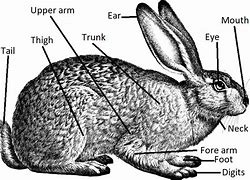.jpg)
Rabbits
The cutest animals

Taxonomy
Biology
- Habitat and range
- Environmental problems
Biology
Reproduction
Rabbits generally live
12 to 15 months, and only about 1 rabbit in 100 lives
through 3 years. Typically, individuals produce 2 to 3
litters per year in northern parts of the range, and 5 to
6 in southern areas.
In the north, first
litters are born as early as late March or April, while in
the south, litters may be born year-round. Size of litters
varies with latitude: rabbits produce 5 to 6 young per
litter in the north and 2 to 3 per litter in the south.
Gestation is 28 or 29 days and females usually breed again
within a few hours of giving birth. Young cottontails are
born nearly furless with their eyes closed. The eyes open
in 7 to 8 days, they leave the nest in 2 to 3 weeks, and
they reach sexual maturity in less than 6 months.
In good conditions,
each pair of cottontails can produce about 18 young during
the breeding season. Weather, disease, predators,
encounters with cars and hunters, and other mortality
factors, however, combine to control populations of
rabbits. The number of individuals in a given population
may change seasonally. Spikes in numbers occur in the
spring and summer followed by significant declines in
winter. No lethal control is effective for long periods of
time because of the reproductive potential of cottontails.
Nesting Cover
Cottontails do not dig
burrows, but rather use natural cavities or burrows
excavated by other animals. Dens that are underground are
used primarily in extremely cold or wet weather, or to
escape from predators. Piles of brush and other cover
often are used as alternatives to burrows.
In spring and fall,
rabbits use a shelter made from grass or weeds, which is
called a “form.” The form is a cavity on the surface of
the ground, usually made in dense cover. It gives rabbits
some protection from weather but is largely used for
concealment. In summer, lush green growth provides both
food and shelter, leaving little need for a form. Rabbits
give birth in a shallow nest depression in the ground.
Habitat
Cottontails are not
distributed evenly across a landscape. They tend to
concentrate in favorable habitats such as brushy fence
rows, edges of fields, gullies filled with debris, piles
of brush, and backyards with extensive landscaping. They
rarely are found in dense forests or open grasslands.
Fallow crop fields may provide suitable habitat.
Cottontails generally
spend their entire lives in an area of 10 acres or less,
but they may move a mile or so from summer to winter
range, or to a new food supply. Lack of food or cover
usually motivates a rabbit to move to another area. In
suburban areas, rabbits are numerous and mobile enough to
fill any open habitat that is created when other rabbits
are removed. Density of populations varies with habitat
quality, but 1 rabbit per acre is a reasonable average.
Food Habits
Rabbits eat flowers
(e.g., tulips) and vegetables (e.g., peas, beans, and
beets) in spring and summer. In fall and winter, they
damage and kill valuable woody trees and shrubs by
clipping and gnawing the bark (Figure 7), particularly
when snowfall is heavy. Crops, such as corn, squash,
cucumbers, tomatoes, potatoes, and some peppers, seem to
be immune from damage by rabbits. Preferences for types of
food vary considerably by region and season. In general,
cottontails seem to prefer plants in the rose family.
Apple trees, black and red raspberries, and blackberries
are the most frequently damaged food-producing woody
plants, although cherry, plum, and nut trees also may be
damaged.
